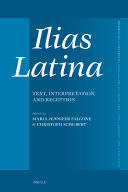Table Of ContentIliasLatina
Mnemosyne
Supplements
monographs on greek and
latin language and literature
ExecutiveEditor
C.Pieper(LeidenUniversity)
EditorialBoard
K.M.Coleman(HarvardUniversity)
C.C.deJonge(LeidenUniversity)
AnnaHeller(UniversityofTours)
T.Reinhardt(OxfordUniversity)
volume 443
Thetitlespublishedinthisseriesarelistedatbrill.com/mns
Ilias Latina
Text,Interpretation,andReception
Editedby
MariaJenniferFalcone
ChristophSchubert
leiden | boston
LibraryofCongressCataloging-in-PublicationData
Names:Falcone,MariaJennifer,editor.|Schubert,Christoph,1970-editor.
Title:IliasLatina:text,interpretation,andreception/editedbyMariaJennifer
Falcone,ChristophSchubert.
Description:Leiden;Boston:Brill,[2022]|Series:Mnemosynesupplements,
0169-8958;volume443|Includesbibliographicalreferencesandindex.|
Identifiers:lccn2021033346(print)|lccn2021033347(ebook)|
isbn9789004469495(hardback)|isbn9789004469532(ebook)
Subjects:lcsh:Homer.IliasLatina.|lcgft:Essays.
Classification:lccpa4037.a5i452022(print)|lccpa4037.a5(ebook)|
ddc883/.01–dc3/eng/20211005
lcrecordavailableathttps://lccn.loc.gov/2021033346
lcebookrecordavailableathttps://lccn.loc.gov/2021033347
TypefacefortheLatin,Greek,andCyrillicscripts:“Brill”.Seeanddownload:brill.com/brill‑typeface.
issn0169-8958
isbn978-90-04-46949-5(hardback)
isbn978-90-04-46953-2(e-book)
Copyright2022byMariaJenniferFalconeandChristophSchubert.PublishedbyKoninklijkeBrillnv,
Leiden,TheNetherlands.
KoninklijkeBrillnvincorporatestheimprintsBrill,BrillNijhoff,BrillHotei,BrillSchöningh,BrillFink,
Brillmentis,Vandenhoeck&Ruprecht,BöhlauVerlagandV&RUnipress.
KoninklijkeBrillnvreservestherighttoprotectthispublicationagainstunauthorizeduse.Requestsfor
re-useand/ortranslationsmustbeaddressedtoKoninklijkeBrillnvviabrill.comorcopyright.com.
Thisbookisprintedonacid-freepaperandproducedinasustainablemanner.
Contents
1 Introduction 1
MariaJenniferFalconeandChristophSchubert
2 ZurStrukturundErzähltechnikderIliasLatina 14
GiuseppeAricò
3 TheIliasLatinaintheContextofAncientEpitomeTranslation 39
MassimoCè
4 BauforminderKürze:ZumUmgangmitepischenStruktureninder
IliasLatina 67
ChristianeReitz
5 Die„Schlachtenbücher“inderIliasLatina:Beobachtungenzu
GefallenenundTodesdarstellung 83
FabianHorn
6 NarrativeStrategienderlysisinausgewähltenSzenenvonIlias24und
dieUmsetzunginderIliasLatina:AufschubimMonumentalenund
HervorhebungderarchaischenanthropologischenGrunderfahrungim
Leidvs.IliaslightmitrömischemAnstrich 115
AntonBierl
7 HomerwithouttheCalories:EatingandDrinkingintheIlias
Latina 143
GeorginaWhite
8 HomeralsHintergrundtextfürdieIliasLatina(!?) 156
GerlindeHuber-Rebenich
9 DieIliasnachVergil:ZurCharakterisierungtrojanischerHeldeninder
IliasLatina 173
MariaJenniferFalcone
10 Baebius’Ovid 194
LuigiGalasso
vi contents
11 AboutSomeNarrativeandDiscursiveDevicesintheIliasLatina 211
JudithRohman
12 DiepoetologischeBedeutungderSphragisderIliasLatina 229
KatrinSchürmann
13 DieAkrostichaderIliasLatinaundihrepoetologischeBedeutung 243
ChristophSchubert
14 FightingOverWomenatTroy:RomanSexualAggressionintheIlias
Latina 281
StevenJ.Green
15 TheGestaBerengariiimperatoris:WitnessoftheIliasLatinaRevivalin
the10thCentury 299
FrédéricDuplessis
16 DieIliasLatinainelegischerForm:ZurRezeptioninder
CentonendichtungTroilusdesAlbertvonStade 316
ThomasGärtner
17 DerMenschenMühsalundderGötterRuh’:EinemittelalterlicheIlias
Latina 328
MicheleC.Ferrari
18 DieRückkehrdesAchilleusnachGriechenland(2):RomandeTroieund
ΠόλεμοςτηςΤρωάδος 363
CaterinaCarpinato
19 GesamtbibliographiezurIliasLatina 382
EdoardoGalfré
IndexCodicum 397
IndexNominum 398
IndexRerum 401
IndexLocorum 406
1
Introduction
MariaJenniferFalconeandChristophSchubert
In the Ilias Latina, one finds a fascinating chapter of Homer’s reception in
the Roman world. Compressed into a single book, which freely follows the
Homericmodelbymakingremarkablechoicesandintroducingpeculiartopics,
this poem narrates Achilles’ wrath, the battles at Troy, the deaths of Patro-
clusandHector.ItsversesareindebtedtoVirgilandOvidandwrittenforthe
Romanpublic,whohadlearnedtoreadtheTrojanWarasthebackgroundto
Aeneas’wanderingsandsubsequentarrivalinLatium.Beingtheonlypoetic
metaphraseof the Iliad inLatinfullytransmittedinthemedievalworld,the
IliasLatinabecameinthatperiodoneof themostimportantsourcesforthe
Trojanepics,alongsidethelateantiquenovelsaboutTroy.InthelaterMiddle
Agesthepoemwasevenaschooltext,astheabundanceofmanuscriptsclearly
shows.UntiltherediscoveryoftheoriginalGreektextintheRenaissance,this
shortpoemmadeasubstantialcontributiontohowreadersintheWestcon-
ceivedofHomerandtheIliad.
Theresearchonthispoemsawasignificantsurgeinthedecadesbetween
the19thand20thcenturies.Thefocuswasplacedonthedating,theauthorship
oftheshortwork(duringtheMiddleAgesitwasentitledasorattributedto,var-
iously,Homerus,LiberHomeri,IliasHomeriandlateralsoPindarus),theprecise
reconstructionandinterpretationoftheacrosticsatthebeginningandatthe
conclusionofthepoem,andtheconstitutiotextusanditsrelationshipwiththe
Greekoriginal,withanattemptatexplainingthedifferencesfromtheHome-
rictradition.Substantiallyboostedbythecriticaleditionof EmilBaehrensin
the PoetaeLatiniMinores,thisstageinthescholarlyappreciationof the Ilias
LatinawasroundedoutbythecontributionsofFriedrichVollmer,specifically
hiscommentaryandneweditionforthePLM.
Welcome Tilroe’s dissertation at the University of Southern California in
1939, which offered a new reading of the text through an edition with com-
mentary,couldhavegivenfreshimpetustotheongoingresearch.Duetothe
outbreakofWorldWarii,however,thisworkwasneverquotedinthe Année
Philologique,andremainedunseenandineffectiveuntilitsdigitalizationafew
yearsago.
AsecondcrucialmovementintheresearchontheIliasLatina,whichcon-
tinues to this day, began with Marco Scaffai’s edition (1982), which provided
© MariaJenniferFalconeandChristophSchubert,2022 | doi:10.1163/9789004469532_002
2 falcone and schubert
scholarswithanewcriticaltextandthestandardcommentary.Bothinthisedi-
tionandlaterintheabridgedversionpublishedinANRW,1Scaffaiofferedan
overviewofpreviousresearch.Inthesecondeditionofhiscommentary(1997),
Scaffai augmented this survey with the studies published in the years 1982–
1994.AtthesametimeasScaffaiorafterhim,G.Broccia,A.GrilloandP.Venini
gainedauthorityinthefieldof studiesontheIliasLatina.Thecompletebib-
liography of this volume demonstrates that since then the attention on the
IliasLatinahasnevercometoastandstill.ButwhiletranslationsintoEnglish
(Kennedy)2andFrench(Fry)3exist,andoneintoGermanisinpreparation,itis
neverthelessstrikingthatthemostrecentmonographsolelydedicatedtothis
textwaswrittendecadesago.4
As a result, both in the conference which preceded this volume and in
thevolumeitself,wehaveaimedtoapproachtheshortpoem,whoseappeal
and importance have not been sufficiently appreciated, from a multitude of
scholarlyperspectives.ThepaperspresentedattheconferenceheldinErlan-
genandsupportedbygenerousresearchgrantsfromtheFriedrich-Alexander-
Universität and the Alfred-Vinzl-Stiftung—and those added to the volume
afterwards (Galasso, Green, Schubert)—reveal a surprising commonality of
approach. On the one hand, the Ilias Latina is primarily interpreted as an
autonomousworkwithliteraryaspirations,whosefeaturescanbeexplained
withreferencetoawork-internalratio;ontheotherhand,thecomparisonof
theIliasLatinawithitsHomericmodelandothertexts,bothGreekandLatin,
allowsforamorepreciseevaluationofthework.Thisleadsfruitfullytoachal-
lenging synthesis between the earliest research on the poem, which mainly
readtheIliasLatinainthelightofHomer,andthemostrecentstudies,which
converselyhighlighttherelativeautonomyoftheLatinpoem.
Thepapersof thisvolumefocusonthreemainissues:1)thedifferentele-
mentsof thenarration,suchasmacro-andmicrostructure,singleBauformen
(“poetic structures”) and motifs, characters and scenes; 2) the Ilias Latina’s
intertextualallusionstoHomerandthetextsoftheRomanpoetictradition,at
thelevelbothofsinglecorrespondencesandofamorecomplexreferencesys-
tem;3)theissuesinvolvingliterarygenreandpoeticprogram,analyzedinthe
explicitlymetaliterarypassagesanddrawnoutfromtheimplicitnarrativeand
poeticchoices.Takinguptheseissuesindifferentformsandfocusinginvari-
ouswaysonthetechniqueofvertere,theauthorsofthisvolumedealwiththe
1 Scaffai1985.
2 Kennedy1998.
3 Fry2014.
4 Grillo1982.
introduction 3
mostimportantquestionsraisedinrecentdecadesandwiththemaintrendsof
currentresearch.Thereis,therefore,noneedhereforaresearchreport,which
wouldhaveonlybeenarepetitionof whatiseasytofindinthepapersthem-
selves.5Thevolumealsoincludespapersfocusedonafourthimportantissue,
namelythemedievalreceptionoftheIliasLatina.Thesechaptersshowthata
newconsiderationofthemanuscriptsandtheoveralltraditionisneededand
couldleadtoasubstantiallynewedition,6afieldwhichlendsitselfforfurther
research.
Whilethevolumedoesnotincludeaspecificcontributiononthepolitical
andsocio-literarycontextofthework,theobservationsscatteredthroughthe
variouschaptersonnarrativetechnique,intertextuality,genreandpoeticpro-
gram provide information on the likely setup of the poem’s target audience.
Thefollowingparagraphsof thisintroductiontrytopresent,howeverbriefly,
thestatusquaestionisonthecontiguousissuesof dating,authorship,andthe
literaryandpoliticalagendaofthepoem.
Sincethefirsthalfofthe19thcenturyandevenbeforethediscoveryofthe
acrostics,afirst-centurycedatingoftheIliasLatina,tobemorenarrowlylim-
ited to the Neronian period at a later point, has gained widespread support
independently from the related issue of authorship.7 Indeed, strong textual
evidence seems to confirm it: 1) the literary allusions to Virgil and Ovid are
regardedasaclearterminuspostquem;2)thereferencetotheJulio-Claudian
dynasty at vv. 899–902 implies at least Augustus’ apotheosis and provides a
terminus ante quem, namely the year 68ce;8 3) remarkable textual parallels
5 Amongthestudiesofthelast25yearswhichposebroaderquestions,thefollowingarepar-
ticularlynoteworthy:Brugnoli2001(lateantiquereception),Polymerakis2004(character-
izationofAchillesandPatroclus,poeticprogramandpoliticalcontext),Polymerakis2005
(figures of Helen, Venus and Paris, political context), Reitz 2007 (literary technique and
genre),Gärtner2007(Helen),Gasti2008(epictranslationtechniqueandcataloguesaswellas
Romanizationandmetapoeticcommentary),Koll2011(Romanizationoffemalecharacters),
FerreiraAlmeida2012(adaptationofHomer),Putnam2018(Virgil’sreceptionandcompar-
isonwithNeronianliterature)andGlei2018(theILasaRomanizedsequeloftheIliad),to
whichImayaddmyobservationsinSchubert1998,229–244(imageofNero,poeticprogram,
structure).
6 Forthestatusquaestionisonthemanuscripttraditioncf.Scaffai1997,29–56,andmorein
depthScaffai1980.Alistofthemanuscriptsuptothe13thcenturycanbefoundinMunk
Olsen1982,413–420.StillusefulareVollmer1913,4–25andManitius1935,123–125.Newaddi-
tionsinScaffai2008andCancelaCilleruelo2017.
7 FirstproposedbyLachmann1841,161f.;forthedatingunderNeroalreadyMüller1860,481.
A research report in Scaffai 1997, 18–29. Important stages are found in Nathansky 1906,
Nathansky1907,276–288,Morelli1914,126–130andScheda1965.
8 IL899–902:Quem[sc.Aenean]nisiservassetmagnarumrectoraquarum,/utprofuguslaetis
4 falcone and schubert
withSeneca’stragediessuggestachronologicalproximitytothisauthor;94)the
peculiardescriptionof Achilles’shield(vv.876–891)containsmotifs(Apollo,
harmony of the spheres, golden age) and keywords (pax, ius, aequitas) that
are typical of Neronian panegyric and recur in contemporary texts, such as
Seneca,CalpurniusSiculus,LucanandtheCarminaEinsidlensia.10Thanksto
ameticulousinterpretationof thislastpassage,Scaffaiproposedrefiningthe
date and placing the composition of the work between the years 60–65ce
instead.11Thereisnodoubtthatthisview,whichhaswonbroadapproval,is
correct.12Moreover,adatingtothelateryearsofthisrangeseemsmoreproba-
ble.13ThefollowingelementsprovidefurtherevidenceforaNeroniandating:1)
themetricaltechniquesuggestsaplacebetweenOvidandtheFlavianauthors;
2)languageandstyle,althoughrelyingonVirgilandOvid,donotshowclear
parallelswithLucanandtheFlavianepics;onthecontrary,theideaof apro-
Trojanmetaphraseof Homerseemstofollowanalternativepoeticproject,14
whichisconsistentwiththeculturalclimateinNero’sreign.15
BeforethediscoveryoftheacrosticsintheproemandepilogueoftheIlias
Latina,theevidencefortheprobableauthorwasrestrictedtothestylisticand
metrical analysis of the poem and the study of its political claims. In 1877,
thewordITALIC*S,detectedintheopeningsectionofthepoem,encouraged
scholarstoattemptamorepreciseattribution.Inthewakeofearlierscholars,
VollmerconclusivelydisprovedSiliusItalicus’authorship16andacknowledged
theattributionofthepoemtoBaebiusItalicus.Thisnameoccursinalateand
otherwisemarginalHumanistmanuscript,theVindobonensis3509(BebiiIta-
licipoetaeclarissimiepithomeinquatuorvigintilibroshomeriiliados) and an
Troiam repararet in arvis / Augustumque genus claris submitteret astris, / non clarae
gentisnobismansissetorigo.Vollmer’sclaimthatsuchversescouldstillhavebeenwrit-
tenintheFlavianperiod(Vollmer1913(comm.),122andVollmer1914)withgoodreason
remainedisolated.RecentlyonthispassagePolymerakis2003.
9 Onthiscf.Courtney2001.
10 OnthisFuchs1967,Scheda1966and1969,Grillo1982,Grillo1992,Scaffai1997,20–22;Schu-
bert1998,230–237.
11 Scaffai1997,26.Fortheyear65asterminusantequem,seeCourtney2001,whoseargument
isbasedontextualparallelswiththeLausPisonis.
12 ToocautiousCourtney1998,933.AnearlierdatingunderClaudiuswasproposedbyHer-
rmann1947basedondubiouspremises.
13 SeeSchubert1998,235withn.28.
14 Cf.Scaffai1997,57f.and469.
15 OnthisPutnam2018.
16 ForthisdebateseeScaffai1997,11–15.465–467andSchanz–Hosius1967,507f.Theat-
temptsofHerrmann1947andDuckworth1967,100–109torelaunchtheSilius-hypothesis
canbeseenasunsuccessful.

